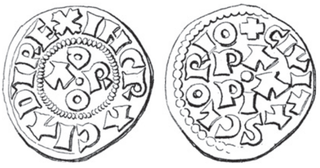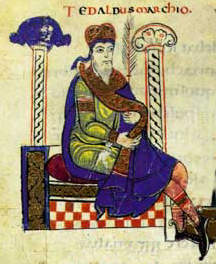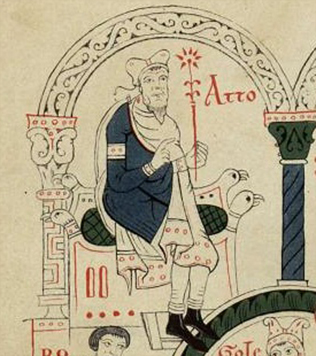Related Research Articles
Fraxinetum or Fraxinet was the site of a Muslim stronghold at the centre of a frontier state in Provence between about 887 and 972. It is identified with modern La Garde-Freinet, near Saint-Tropez. The fortress was established by Muslims from al-Andalus. From this base, the Muslims raided up the Rhône Valley, into Piedmont and as far as the Abbey of Saint Gall. Their main business was slave-raiding of Europeans for export to Islamic markets. For a time, they controlled the passes through the western Alps. They withstood several attempts to oust them, but were finally defeated by the combined forces of the Provençal and Piedmontese nobility at the battle of Tourtour in 972.

Berengar II was the King of Italy from 950 until his deposition in 961. He was a scion of the Anscarid and Unruoching dynasties, and was named after his maternal grandfather, Berengar I. He succeeded his father as Margrave of Ivrea around 923, and after 940 led the aristocratic opposition to kings Hugh and Lothair II. In 950 he succeeded the latter and had his son, Adalbert crowned as his co-ruler. In 952 he recognised the suzerainty of Otto I of Germany, but he later joined a revolt against him. In 960 he invaded the Papal States, and the next year his kingdom was conquered by Otto. Berengar remained at large until his surrender in 964. He died imprisoned in Germany two years later.

Arduin was an Italian nobleman who was King of Italy from 1002 until 1014.

Adalbert was the king of Italy from 950 until 961, ruling jointly with his father, Berengar II. After their deposition, Adalbert continued to claim the Italian kingdom until his defeat in battle by the forces of Otto I in 965. Since he was the second Adalbert in his family, the Anscarids, he is sometimes numbered Adalbert II. His name is occasionally, especially in older works, shortened to Albert.

Tedald, of the House of Canossa, was the count of Brescia from 980, Modena, Ferrara, and Reggio from 981, and Mantua from 1006. He used the title of margrave because of his vast comital holdings and their frontier nature. His family's seat was Canossa and he was the son of Adalbert Azzo of Canossa who had supported Otto I against Berengar of Ivrea and Adalbert of Ivrea. His rise was largely due to his loyalty to the Ottonian Dynasty.
Hubert was the illegitimate son of King Hugh of Italy and his concubine Wandelmoda. He became Margrave of Tuscany in 936 and Duke of Spoleto and Margrave of Camerino in 943.
The March of Ivrea was a large frontier county (march) in the northwest of the medieval Italian kingdom from the late 9th to the early 11th century. Its capital was Ivrea in present-day Piedmont, and it was held by a Burgundian family of margraves called the Anscarids. The march was the primary frontier between Italy and Upper Burgundy and served as a defense against any interference from that state.

The Anscarids or the House of Ivrea were a medieval dynasty of Frankish origin which rose to prominence in Northern Italy in the tenth century, even briefly holding the Italian throne. The main branch ruled the County of Burgundy from the eleventh to fourteenth centuries and it was one of their members who first declared himself a count palatine. The cadet Castilian branch of Ivrea ruled the Kingdom of Galicia from 1111 and the Kingdoms of Castile and León from 1126 until 1369. The House of Trastámara, which ruled in Castile, Aragon, Naples, and Navarre at various points between the late 14th and early 16th centuries, was an illegitimate cadet branch of that family.
The House of Obertenghi were a prominent Italian noble family of Frankish origin descended from Viscount Adalbert III, first Margrave of Milan.

Adalbert Atto was the first Count of Canossa and founder of that noble house which eventually was to play a determinant role in the political settling of Regnum Italicum and the Investiture Controversy in the eleventh and twelfth centuries.
Ulric Manfred II or Manfred Ulric was the count of Turin and marquis of Susa in the early 11th century. He was the last male margrave from the Arduinid dynasty. Ulric Manfred's daughter, Adelaide, inherited the majority of his property. Through marriage to Adelaide, Otto of Savoy, a younger son of Count Humbert I of Savoy became margrave of Turin. Their descendants would later comprise the House of Savoy who ruled Sardinia and Italy.
The March or Marquisate of Turin was a territory of medieval Italy from the mid-10th century, when it was established as the Arduinic March. It comprised several counties in Piedmont, including the counties of Turin, Auriate, Albenga and, probably, Ventimiglia. The confines of the march thus stretched across the Po Valley from the Western Alps in the north, to the Ligurian Sea.
Conrad Cono(n) (Italian: Corrado Conone) (died 997) was the Margrave of Ivrea from 970 to his death and Duke of Spoleto and Camerino (996–997). He was the third son of Berengar II of Italy and Willa of Tuscany. His elder brothers were Adalbert and Guy, both of whom ruled the march before him. His father made him, possibly, the first Count of Ventimiglia.
Manfred I or Maginfred was the second Arduinici marquis of Susa from 977 until his death. Manfred was the eldest son of Arduin Glaber, from whom he inherited the county of Auriate and the vast March of Susa. The march extended from the Susa Valley by the Alps south across the Po to the Ligurian Sea. Although he ruled for almost twenty-five years, there is little evidence of his activities in surviving sources. Under him, Pavia became a mercantile city. He also controlled the road between Genoa and Marseilles.

Adelaide of Turin was the countess of part of the March of Ivrea and the marchioness of Turin in Northwestern Italy from 1034 to her death. She was the last of the Arduinici. She is sometimes compared to her second cousin and close contemporary, Matilda of Tuscany.
Dado was the Count of Pombia from 967. The comitatus of Pombia, in what is now Northern Italy, included Novara at the time.
The Arduinici were a noble Frankish family that immigrated to Italy in the early tenth century, possibly from Neustria. They were descended from and take their name after one Arduin (Hardouin).
Auriate was a county in medieval Italy on the eastern slopes of the Western Alps lying between Cuneo and Saluzzo. The county existed from the late ninth century to the middle of the tenth. The name of the county survives in that of the comune of Valloriate.
Anscar was a magnate in the Kingdom of Italy who served as Count of Pavia, Margrave of Ivrea (929–36) and Duke of Spoleto (936–40). He is sometimes numbered "Anscar II" to distinguish him from his grandfather, Anscar I of Ivrea. Described by Liutprand of Cremona as courageous and impulsive, he died in the battle of Spoleto.
Willa of Spoleto was the daughter of Boniface I, duke of Spoleto. Through marriage to Hubert, Duke of Spoleto Willa became duchess of Spoleto and margravine of Tuscany.
References
- C. Manaresi, ed., I placiti del ‘regnum Italiae’, 3 vols. (Rome, 1955–1960).
- M. G. Bertolini, "Arduino", Dizionario biografico degli Italiani, VI (Rome: Società Grafica Romana, 1964), 49–52